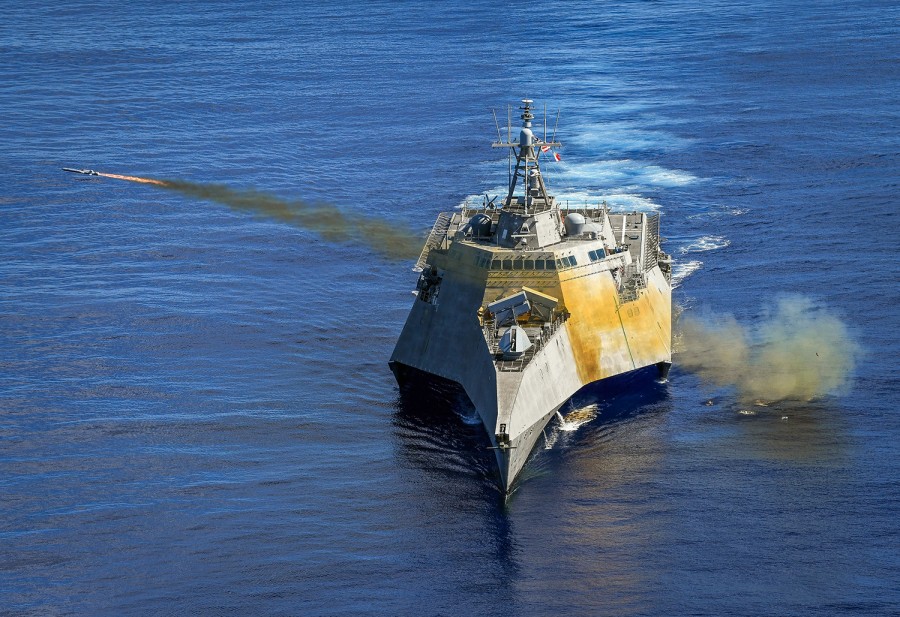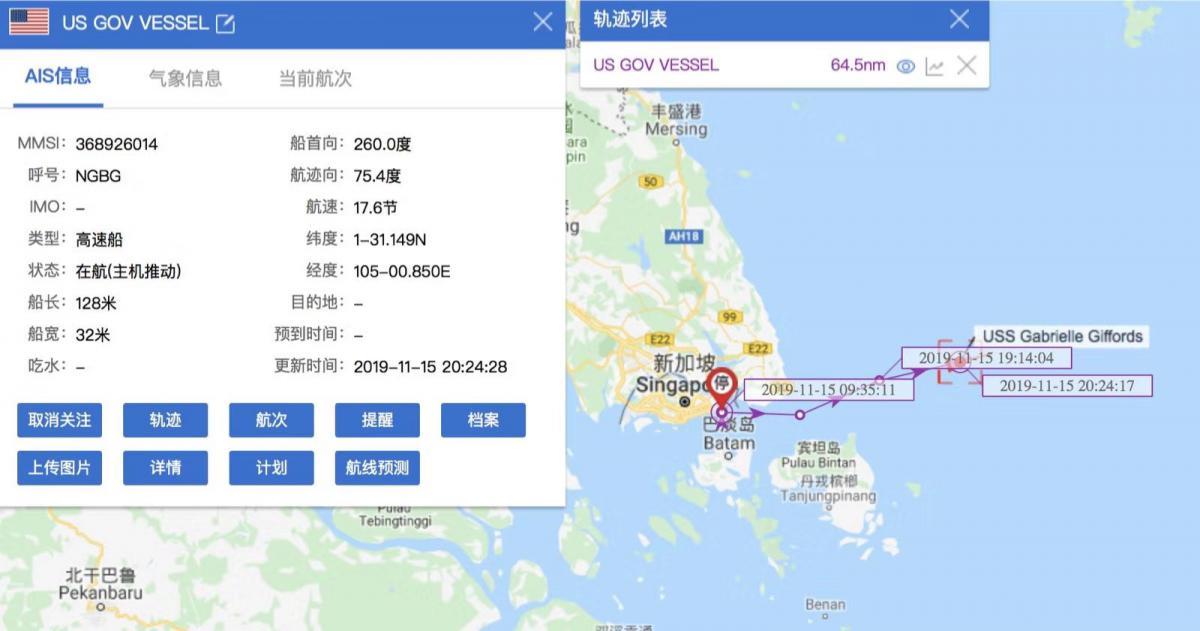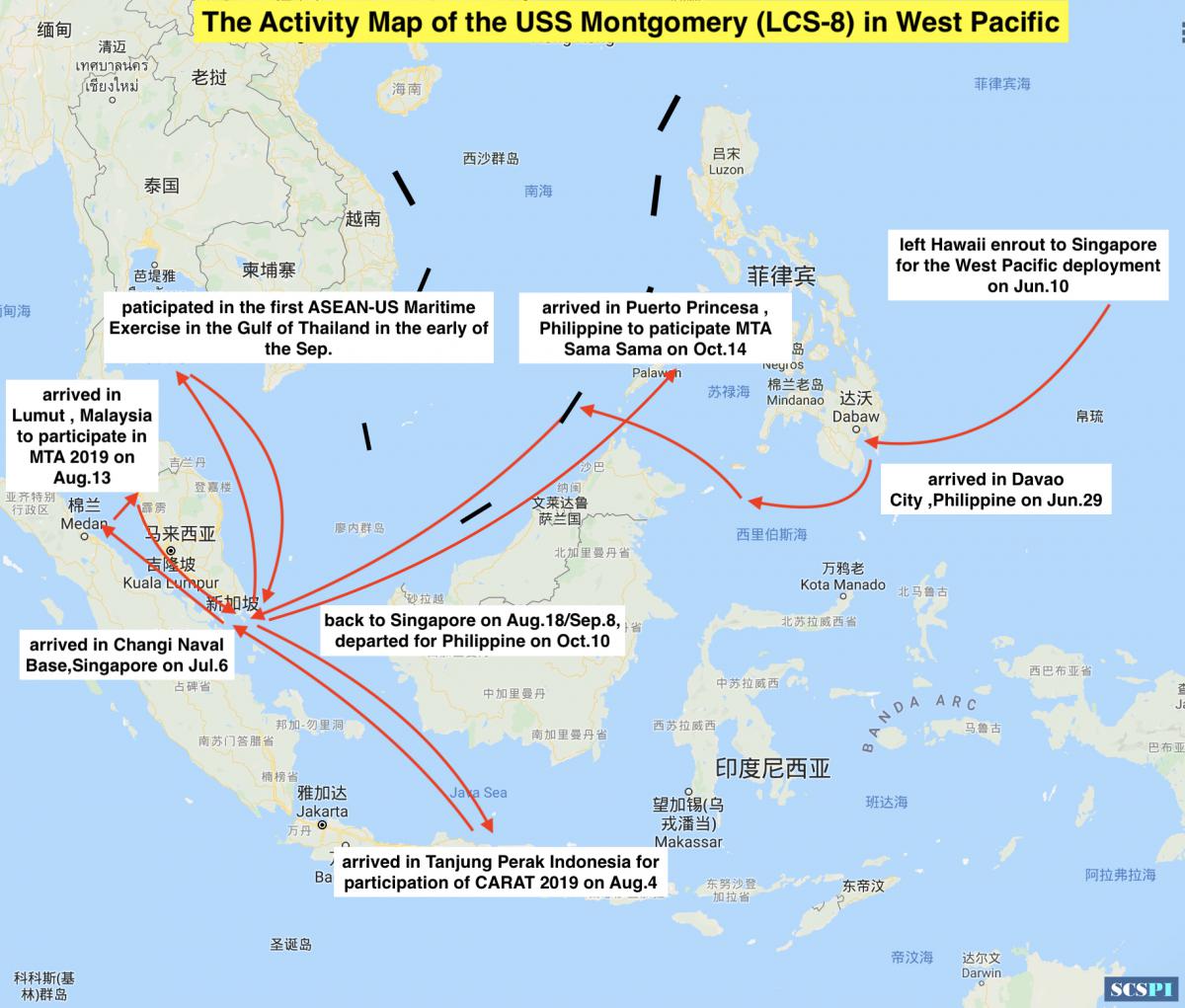
On October 1st, China's National Day, USS Gabrielle Giffords fires ‘sea-skimming’ Naval Strike Missile in Indo-Pacific for first time.
The precision strike weapon “can find and destroy enemy ships at distances up to 100 nautical miles away,” the statement said. It zips over the ocean “at sea-skimming altitude,
has terrain-following capability and uses an advanced seeker for precise targeting in challenging conditions.”
Source: www.stripes.com
By the end of September, the USS Gabrielle Giffords(LCS-10) had arrived in Guam. Around the early October, it conducted a front-deployed operation in the South China Sea. According to the latest information from the Automatic Identification System(AIS), it has left Changi Naval Base (CNB) in Singapore for the South China Sea for another navigation on November 15th.

On November 15th, the USS Gabrielle Giffords has left Changi Naval Base (CNB) in Singapore for the South China Sea
This would mark the second deployment of a littoral combat ship (LCS) of the United States Navy (US Navy) to the Western Pacific in this short term. Before that, the USS Montgomery (LCS-8), another US Navy LCS, had arrived at CNB on July 6th. In a recent deployment, it conducted operations together with Royal Australian Navy Anzac-class frigate HMAS Stuart (FFH 153) and fleet replenishment vessel HMAS Sirius (O 266) in the South China Sea, November 6th -12th.
This is the first time that the US Navy has deployed two LCSs to the South China Sea at the same time, and it is also a redeployment of LCSs to this region after a 19-month lapse. What are the intentions and characteristics of this deployment against the background of the intensifying strategic competition going on in the South China Sea?
New Deployment in a New Situation
In late 1990s, the US Navy realized that its Cold War-era cruisers and destroyers had been designed for open-ocean warfare and would be vulnerable in shallow coastal waters, where they would face dangers from high-speed boats, small submarines, sea mines, and shore-based anti-ship missiles. Thus, the US Navy saw the urgent need for a surface warfare platform in littoral waterways, which led to the LCS project. In 2003, the US Navy started to allocate USD 15 billion for relevant analysis, validation, and research and launched its experimental LCS, Sea Fighter (FSF-1), in the same year. In 2004, two shipbuilders, Lockheed Martin and General Dynamics, gave the US Navy their proposals, based on which they built Freedom-class and Independence-class LCSs. With an original plan to build 55 LCSs, the US Navy reduced the number to 32 around 2014 due to the changing maritime situations and emergence of the next-generation guided-missile frigates (FFG(X)) program. The Independence-class LCSs are co-designed by General Dynamics and Austal and built by the latter. So far, a total of 11 Independence-class LCSs have been built and delivered to the US Navy, all of which have been deployed to the Naval Base San Diego (NBSD), California, under the command of Littoral Combat Ship Squadron (LCSRON) 1. The Freedom-class LCSs are designed by Lockheed Martin and built by Fincantieri Marinette Marine. So far, a total of eight Freedom-class LCSs have been built and delivered to the US Navy, all deployed to the Naval Station Mayport, Florida, under the command of Littoral Combat Ship Squadron (LCSRON) 2.
Since April 2013 when the USS Freedom (LCS-1), the first LCS of U.S Navy, was deployed to Singapore, several LCSs have been deployed to the country including the USS Fort Worth (LCS-3) and USS Coronado (LCS-4), and the USS Gabrielle Giffords has been the fifth LCS deployed to Singapore. The US Navy, despite previous plans to deploy one LCS to Bahrain in the Persian Gulf and two to Singapore in the Asia-Pacific Region in 2018, postponed the deployments to 2019 due to the fact that most of the LCSs on the West Coast were in either maintenance or operational testing.
In an era of great power competition, the US Navy did not announce the deployment date of the USS Montgomery in advance. According to public records, however, the USS Montgomery departed its homeport of NBSD in late May for deployment to the Western Pacific. According to AIS, the USS Montgomery ended its visit to Pearl Harbor in Hawaii on roughly June 10th and departed for the Western Pacific; the ship was again traced on June 29th when it arrived in Davao, a city in the southern Philippines. After its visit to the Philippines, the USS Montgomery sailed through the South China Sea into Singapore and arrived at CNB on July 6th. The USS Gabrielle Giffords departed NBSD in early September for deployment to the Western Pacific. On September 27th, the USS Gabrielle Giffords participated in Exercise Pacific Griffin 2019 organized by the US Navy and the Republic of Singapore Navy in waters off the coast of Guam, during which it engaged in surface warfare maneuvers and showed the warfare capabilities of its stealth-enhanced naval strike missiles (NSMs).

The activity map of the USS Montgomery(LCS-8) in the Western Pacific
Compared with the US Navy’s guided-missile cruisers, guided-missile destroyers, amphibious assault ships, or other surface warships, LCSs can leverage unique operational advantages in flexible mission module combination and excellent maneuverability for littoral warfare.
Currently, LCSs feature three modules, namely surface warfare, anti-mine warfare, and anti-submarine warfare. They can be equipped with different modules for different missions, where there might be different priorities. The USS Gabrielle Giffords deployed to Singapore marks the first warship with real-combat NSMs, a ship-based anti-ship missile developed by the Norwegian company Kongsberg Defence & Aerospace, with a range of around 185 km. As such, it can be inferred that the USS Gabrielle Giffords was equipped with surface warfare module when deployed to the Western Pacific.
US officials and some nongovernmental figures have long argued that a small-scale regional war in the South China Sea between China and the US may take place. In that case, surface warfare and anti-submarine warfare would dominate this regional war, which is why the US Navy has attached great importance to the surface warfare maneuvers in recent years. In addition to the equipment of the USS Gabrielle Giffords with NSMs, the USS Montgomery was equipped with a surface warfare package during its deployment, according to public records. Therefore, the US Navy’s deployment of two LCSs to Singapore demonstrates its exceptional attention to surface warfare in the South China Sea. Unlike the USS Gabrielle Giffords, the USS Montgomery was equipped neither with NSMs nor with launching module for harpoon anti-ship missiles, according to the recently released pictures of the ship by the US Navy. Therefore, it still remains to be seen what ship-based weapons the USS Montgomery has applied for surface warfare.
Besides anti-ship missiles, the two LCSs currently deployed by the US Navy both carry the MH-60S Seahawk helicopters and MQ-8B Fire Scout unmanned helicopter . The former is the US Navy’s most widely used ship-based helicopter, which can perform various missions including maritime supply, search and rescue, surface warfare, anti-submarine warfare, and anti-mine warfare; the latter can conduct not only aerial reconnaissance but also aerial guidance on the beyond-visual-range strike of anti-ship missiles in LCSs’ anti-ship warfare, which can enhance the strike performance of anti-ship missiles. This beyond-visual-range communication relay guidance can help protect the crew in warfare, which is of great significance in anti-ship warfare in the relatively limited waters of the South China Sea.
Can LCSs Still Exert Their Powers?
Compared with the US Navy’s other surface warfare platforms, LCSs have the following advantages for military operations in the South China Sea.
Firstly, LCSs have a shallow draft, which enables them to enter and exit primitive ports freely. In contrast with an Arleigh Burke guided-missile destroyer with 31-feet draft, LCSs have a draft of only 15.1 feet, which allows them to conduct special missions in some shallow water areas. During the Maritime Training Activity (MTA) that the US Navy and the Royal Malaysian Navy started on August 14th, for instance, the USS Montgomery was able to directly arrive at the dock of Lumut Naval Base in Malaysia, which is rather difficult for other large surface warships of the US Navy. The capability to freely enter shallow waters will, without any doubt, considerably improve littoral warfare, landing operations, and other military operations. In this sense, the US Navy’s LCSs are deservedly the best of the best among all the current surface warships around the world.
Secondly, LCSs are specialized and agile. As mentioned earlier, LCSs can be equipped with surface warfare, anti-mine warfare, and anti-submarine warfare modules if the mission requires. Therefore, LCSs can not only conduct military operations alone, but also be along with other surface warships to carry out specific military missions. LCSs with surface warfare modules, such as the USS Montgomery and USS Gabrielle Giffords, will conduct anti-ship missions in the surface warship strike group. To date, the US Navy has not incorporated LCSs into its aircraft carrier strike group. Considering the increasing performance of American LCSs and the slow progress in the next-generation guided-missile frigates (FFG(X)) program, however, it is still possible for LCSs to be incorporated into the aircraft carrier strike group for surface warfare in the future, especially in the South China Sea. Nevertheless, the air defense capability of LCSs, only armed with RIM-116 Rolling Airframe Missile SeaRAM, lags behind that of Arleigh Burke-class destroyers and Ticonderoga-class cruisers, thus raising the risks in single-warship surface operations. It is likely that LCSs’ surface operations require support and protection from other large air defense warships.
Thirdly, LCSs are good at intelligence gathering and scouting, and are thus able to perform special reconnaissance missions. Compared with other surface warships, LCSs are characterized by their high speed, with the potential top speed of nearly 50 knots, which offers them great advantages in scouting and surveillance missions. In sea areas with numerous islands and reefs in the South China Sea, like the Nansha area, LCSs can use this advantage to carry out close reconnaissance missions and protect the freedom of navigation operations (FONOPs) of the US Navy’s other warships. For example, when the USS Coronado was deployed to Singapore in 2017, it repeatedly carried out military missions in the South China Sea. In addition, LCSs’ onboard MQ-8B Fire Scout helicopter UAVs can track 200 surface or air targets simultaneously through its airborne AN/ZPY-4(V)1 X-band synthetic aperture radar, providing strong support in ISR operation. With its onboard Coastal Battlefield Reconnaissance and Analysis (COBRA), the MQ-8B Fire Scout unmanned helicopters can also detect underwater targets around the LCSs such as mines and submarines.
Fourthly, their deployment takes a long time overseas but requires less personnel. In recent years, the US Navy has restructured its LCS fleets, establishing two Littoral Combat Ship Squadrons (LCSRON). LCSRON 1 is all equipped with Independence-class LCSs; based at NBSD, California, it is mainly responsible for Asia-Pacific operations. LCSRON 2 is all with Free-class LCSs; based at Naval Station Mayport, it is mainly responsible for Atlantic operations. The new formation has been matched with new personnel arrangements. Each ship has a Blue crew and a Gold crew, which will shift crews every four to six months. However, the LCSs will stay put for their missions. Specifically, their deployment overseas will last for 16 months. In contrast, the deployment of other surface warships overseas generally lasts six months.
Intentions and Features of US Navy’s Deployment of LCSs to the South China Sea
The reasons why the US Navy took Singapore as the front-line base to deploy LCSs to the Western Pacific are as follows.
Firstly, CNB in Singapore enjoys a sound logistics support system, which can provide military supply and warship maintenance support to the US Navy in Western Pacific. The latest surface warfare weapon of the US Navy as it is, LCS still needs improvements in its reliability and stability. In 2016, the USS Fort Worth’s power system broke down when it was deployed to Singapore. It had been in repair for nearly half a year at the dock at CNB. The propulsion system of another LCS, USS Coronado, also failed during its deployment to the Western Pacific in September 2016 and then was repaired in Pearl Harbor, Hawaii, for nearly a month. To ensure the smooth deployment of LCSs to the Western Pacific, the US Navy has formed a team composed of active-duty military personnel, civilian personnel, and defense contractors at CNB, which is responsible for the maintenance of LCSs in the Western Pacific. Even if a LCS breaks down while cruising outside Singapore, such as in the East China Sea or the Sea of Japan, team members can quickly arrive at the scene to offer help.
Secondly, CNB’s unique geographical advantage — proximity to the South China Sea — enables fast operations for the US Navy in case of emergencies. Recent years have seen the rise of the US military campaigns in the South China Sea, gradually normalized FONOPs, as well as more acute disputes between the neighboring countries of the South China Sea in the construction of islands and reefs and the exploration and development of oil and gas, making the South China Sea a focus in global geopolitics. Singapore is about 1,000 kilometers away from the Nansha Islands. In the event of emergencies or conflicts between countries, US LCSs can leave CNB and reach Nansha Islands quickly, thanks to their high speed, as the first surface force on the spot.
The US Navy deployed LCSs to Singapore again after a 19-month hiatus to carry out front-line operations in the Western Pacific, which has the following new features:
First, the position and role of LCSs in the US combat system is getting valued. Before its deployment in April 2019, the USS Montgomery completed its very first Surface Warfare Advanced Tactical Training (SWATT) since LCSs were deployed to the US Navy, which is generally only available for large surface warships such as aircraft carrier strike groups, amphibious ready groups, guided-missile destroyers, and guided-missile cruisers. During the training, the USS Montgomery carried out gunnery exercises and Rolling Airframe Missile SeaRAM air defense drills, which significantly improved its warfare capabilities and operation of weapons. This advanced tactical training shows that the role of such weapon platforms has great importance for the US Navy Combat system, and has even enhanced it. On the one hand, this is due to the considerable improvements of LCSs’ performance after repeated upgrading and testing in recent years. Its reconnaissance and fighting capabilities will step up to a higher level once MQ-8C unmanned helicopters are loaded. In the Western Pacific, US Navy surface warships have been keeping a close eye on illegal smuggling to North Korea in the East China Sea and the Yellow Sea, but less force is deployed in the South China Sea. Nevertheless, LCSs can make up for this weak link.
Second, this dual-ship deployment has been applied for the first time. In the past, the USS Freedom, USS Fort Worth. and USS Coronado were all deployed alone. This time, however, has witnessed joint deployment of the USS Montgomery and USS Gabrielle Giffords, the former launched at the end of May and the latter early September. The three-month interval makes it possible to keep the dual-ship deployment, the greatest advantage of which lies in the significant improvement in its efficiency in military missions. Even if one of the two LCSs fails, it will not have a severe impact on the mission.
Third, surface warfare capability has become one of the key points of this deployment. The USS Montgomery and USS Gabrielle Giffords are both armed with surface warfare modules, enabling them to effectively conduct surface warfare missions. In particular, the USS Gabrielle Giffords carries NSMs which, as the US military has proudly claimed, can pose a fatal threat to surface warships of other countries. In recent years, the PLA Navy has made great progress in armament building and its overall control in the South China Sea, which is obviously not what the US wants to see. It has been an important target for the US military to proactively seek military deterrence in the South China Sea and prepare for potential military conflicts for years. The deployment of LCSs equipped with advanced anti-ship weapons to the South China Sea indirectly indicates a subtle change in the US military’s scheme in the South China Sea, that is, previous reconnaissance, deterrence, and command of the situation have turned into implementing military strikes and achieving better striking performance.

